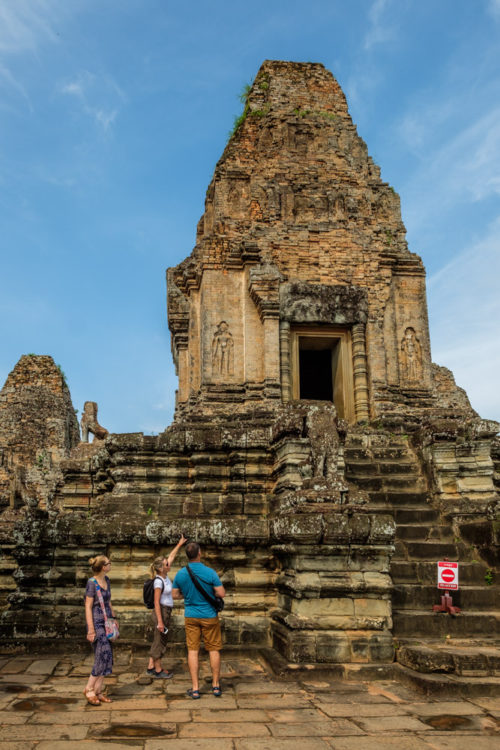
Second day at Cambodia we wanted to explore temples of Angkor. Angkor which in Khmer language means Capital City, was the capital Khmer Empire, seems to have flourished from approximately the 9th to 15th centuries. Angkor was a megacity supporting at least 0.1% of the global population during 1010-1220 CE.
The word Angkor is derived from the Sanskrit nagara, meaning “city”. The Angkorian period began in AD 802, when the Khmer Hindu monarch Jayavarman II declared himself a “Deva Raja” god-king, and lasted until the late 14th century, first falling under Ayutthayan suzerainty in 1351 CE. A Khmer rebellion against these Siamese authority resulted in the 1431 CE sacking of Angkor by Ayutthaya, causing its population to migrate south to Longvek.
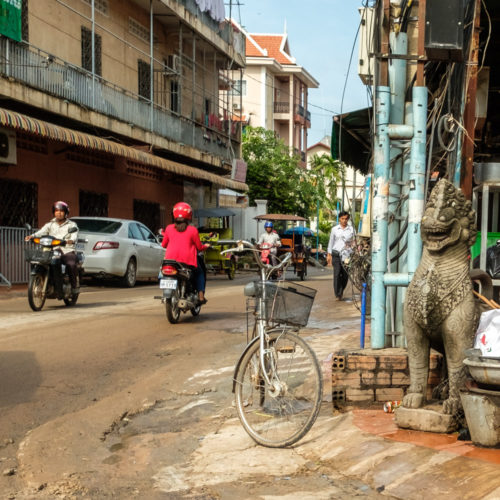
Abandoned Angkor was lost to civilization for nearly 400 years. The ruins of Angkor are located amid forests and farmland north of the Great Lake (Tonlé Sap) and south of the Kulen Hills, near modern-day Siem Reap city, in Siem Reap Province.
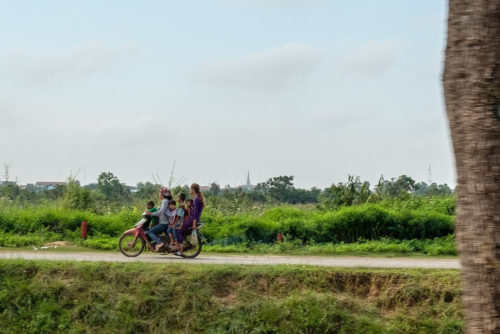
The temples of the Angkor area number over one thousand, ranging in scale from nondescript piles of brick rubble scattered through rice fields to the Angkor Wat, said to be the world’s largest single religious monument. Many of the temples at Angkor have been restored, and together, they comprise the most significant site of Khmer architecture.
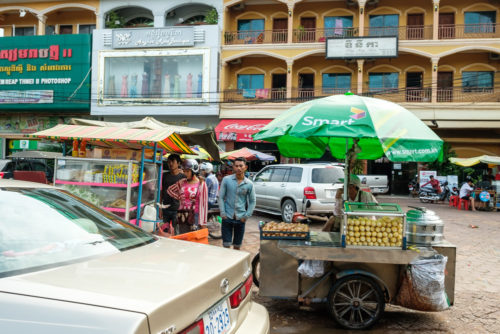
Angkor was declared a UNESCO World Heritage site in 1992 CE. At the same time, it was also placed on the List of World Heritage in Danger due to looting, a declining water table, and unsustainable tourism.
The temples of Angkor are highly symbolic structures. The foremost Hindu concept is the temple-mountain, where the temple is built as a representation of the mythical Mount Meru: this is why so many temples, including Angkor Wat itself, are surrounded by moats, built in a mountain-like pyramidal shape and topped by precisely five towers, representing the five peaks of Mount Meru. The linga, representing the god Shiva, was also critical and while the lingas themselves have largely gone, linga peetas (carved, table-like blocks of stone) can be found in many if not most rooms in the temples. There was also a political element to it all: most kings wanted to build their own state temples to symbolize their kingdom and their rule.
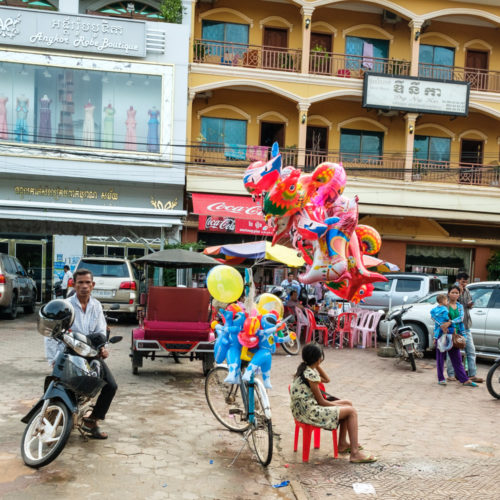
Angkor group of temples can broadly be categorized into four groups:
- Angkor Wat and Angkor Thom, the grandest temple of all and the ancient capital next to it
- Little Circuit (Le Petit Circuit), taking in major sites to the east of Angkor Thom
- Big Circuit (Le Grand Circuit), taking in major sites north and further out east
- Roluos group, 15km east from Siem Reap along National Highway 6
- Outlying temples, located over 20km from Angkor Wat
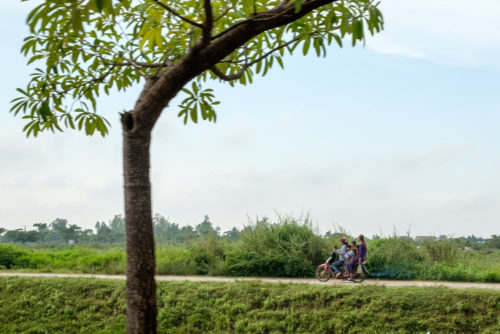
Tickets
We decided for our first day at Angkor, to go on our own exploration of the twenty-six kilometer Big Circuit tour. Big Circuit or Grand Circuit is an extension on the little circuit but taking in Preah Khan, Preah Neak Pean to the Eastern Mebon and the various monuments like Ta Som, Preah Rup. The Big Circuit encompasses a good representation of the rich variety of architecture of Angkor.
Our first destination was to buy tickets. Tickets are required to enter the Angkor area. They are no longer for sale at the front gate of any temple. Instead you will need to purchase them at the Ticket counter which is 7 km away. You will be turned away at the Temple if you arrive without tickets. Tickets are available from 5:00AM- 6:30Pm. They cost for 1-day (US$20), 3-day (US$40), or 7-day (US$60) duration. Children under 12 enter for free after showing a passport. The 3-day pass which is what we went for, is valid for any 3 days within a week, while the 7-day pass is valid for any 7 days within a month.
Srah Srang
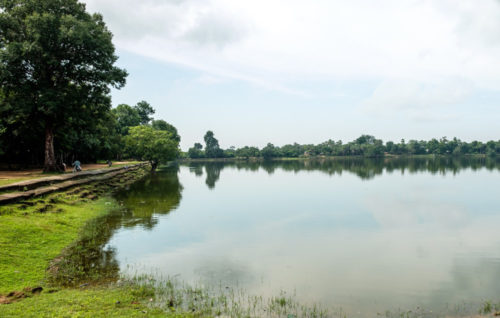
From the ticket counter we went towards the Srah Srang which is a sort is a baray or reservoir located south of the East Baray and east of Banteay Kdei. It was dug in the mid-10th century, by initiative of Kavindrarimathana, Buddhist minister of Rajendravarman II.
It was later modified around the year 1200 by Jayavarman VII, who also added the laterite landing-stage at its western side, probably because the East Baray had been overwhelmed by sediment and had begun malfunctioning. A 1600 sq. meter cemetery was discovered at the north-west corner of the reservoir. Mortuary jars containing cremated remains and other artifacts dating from the reign of Udayadityavarman II were excavated by B.P. Groslier. At present Srah Srang measures 700 by 350 m and is still partially flooded.
Pre Rup
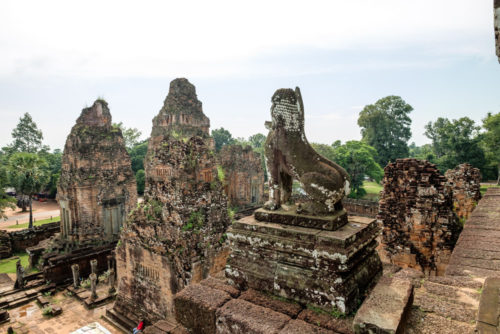
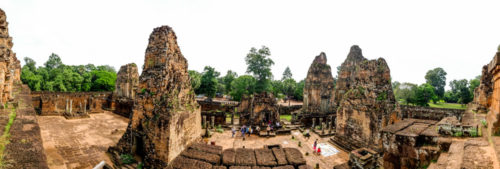
Coming from Srah Srang, Pre Rup is located at a bend in the road between Srah Srang and East Mebon. It is a large temple – very difficult to miss.

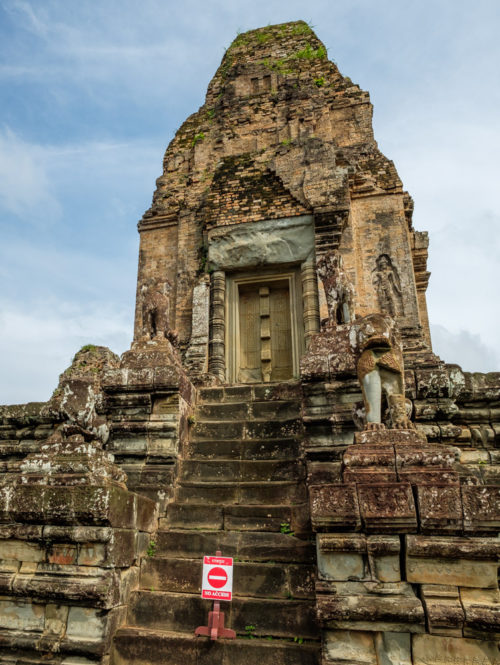
King Rajendravarman constructed Pre Rup sometime in the 10th Century to be the capital of the new Khmer Empire. Pre Rup is one of the most architecturally and stylistically noteworthy structures in Angkor. Ornate bas-reliefs adorn the temple walls and towers. Carved guardian lions sit atop the temple terraces. And from atop the terraces, visitors enjoy panoramic views of the surrounding countryside.
After the death of King Jayavarman IV, the Khmer Empire was not strongly unified. One of Jayavarman IV’s sons took over his father’s kingship, but he died after a few short years. Rajendravarman, Jayavarman IV’s cousin, filled the authoritative void. As king, Rajendravarman decided to relocate the Khmer capital to the south bank of the East Baray, where Pre Rup now lies.
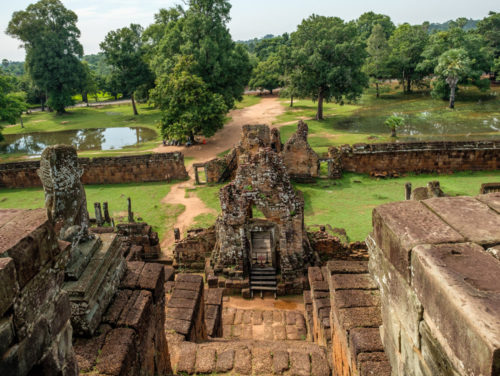
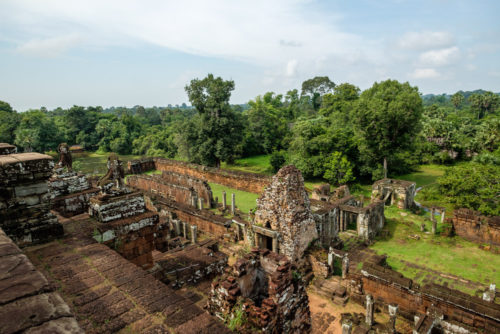
Pre Rup’s ancient name is Rajendrabhadresvara – a paying of homage to its founding king. The name Pre Rup means “turning the body”, referring to Khmer cremation traditions. Although cremation may’ve taken place at Pre Rup, this modern name seems to negate the enormous historical significance of Pre Rup as one of the capitals of the Khmer Empire.
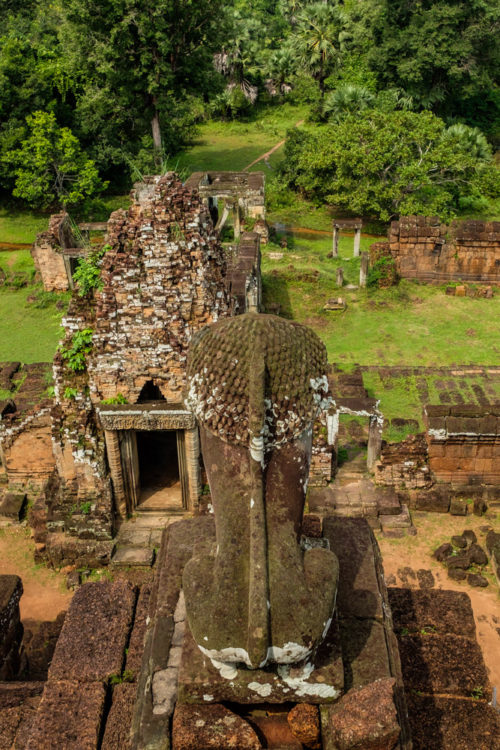
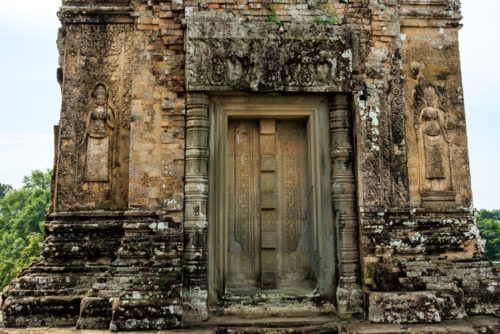
The towers, or prasats, that adorn Pre Rup are well preserved. Pre Rup has been the object of ongoing restorative efforts. The bas-relief artwork and hieroglyphs are magnificently detailed, and the lion statuary surrounds the temple with a royal air.
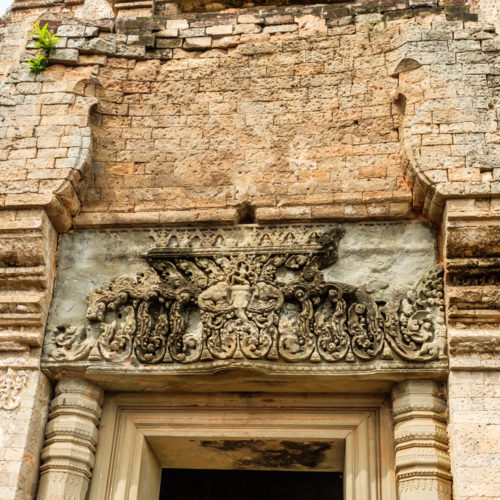
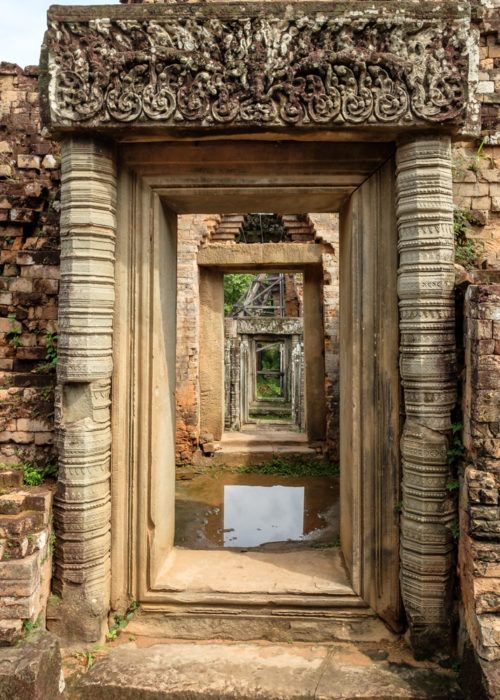
Pre Rup is best viewed when the sun is low in the sky, either in the early morning or late afternoon hours. During these hours, the temple stone appears rich in texture, and a variety of reddish hues become appreciable.
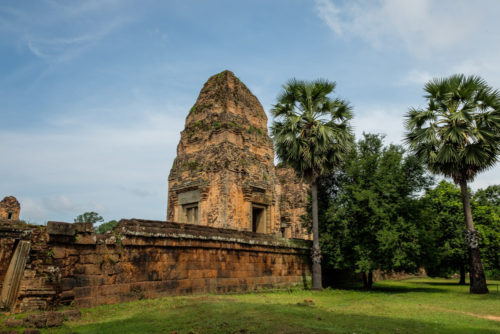

The temple’s terrace can be difficult to scale. Its stairs are steep, so drink plenty of water, wear a good pair of walking shoes, and be prepared for some thigh-burning stair climbing.
East Mebon
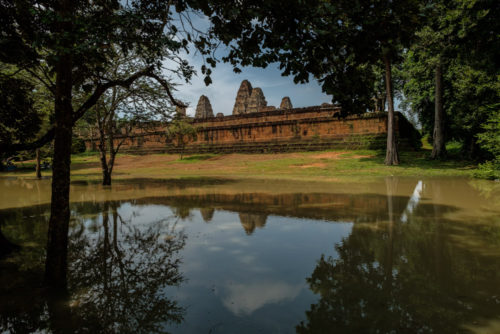
Next we met a temple which was similar in structure as Pre Rup, the East Mebon. East Mebon is a large temple-mountain-like ruin, rising three levels and crowned by five towers. Jayavarman IV, a usurper to the throne, moved the capital from Angkor to Koh Ker in 928AD. Sixteen years later Rajendravarman II returned the capital to Angkor and shortly thereafter constructed East Mebon on an island in the middle of the now dry Eastern Baray. The temple is dedicated to Shiva in honor of the king’s parents. Inscriptions indicate that it was also built to help re-establish the continuity of kingship at Angkor in light of the interruption that occurred when the seat of power had been moved to Koh Ker.
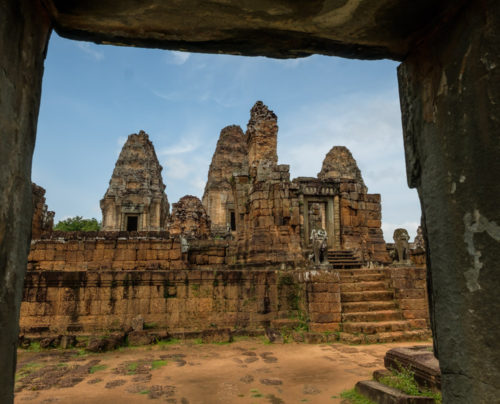
On arriving at the temple, one of the first things you’ll notice is are the large elephants standing at each corner of the lowest tier. The elephants are carved from a single block of stone. Gateways in the center of each side lead up to the second and third platforms.
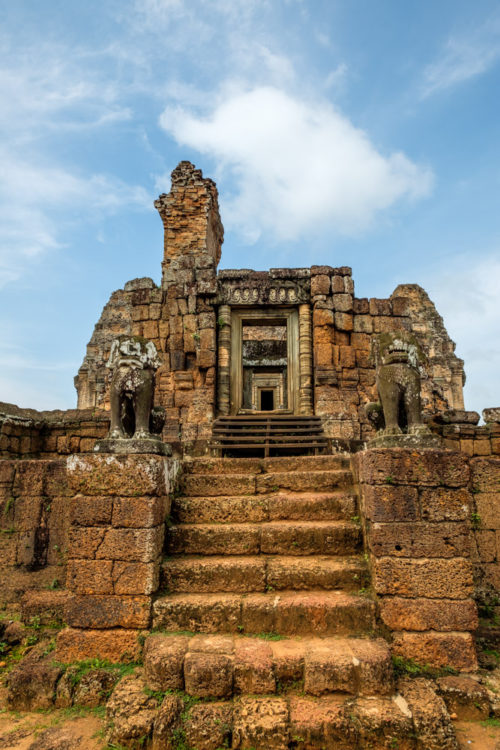
Several inscriptions found in the vicinity as well as the foundation stele – dated 952 describe the placing in the various sanctuaries of the linga Sri Rajendresvara, of several gods – notably Shiva and Parvati in the likeness of the mother and the father of King Rajendravarman in addition to Vishnu with Brahma. Eight linga of the god in eight forms were also placed in the eight small towers of the surrounding court. The Mebon belongs to a group of temples consecrated to the memory of deified parents.
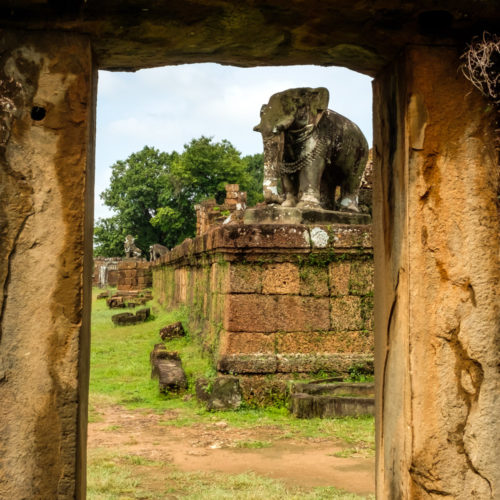
According to an inscription, the walls were originally covered externally with a lime-based plaster coating (as evident at Pre Rup temple) with the pitted hammer marks in the brickwork to adhere the stucco onto the towers, the only remaining evidence.
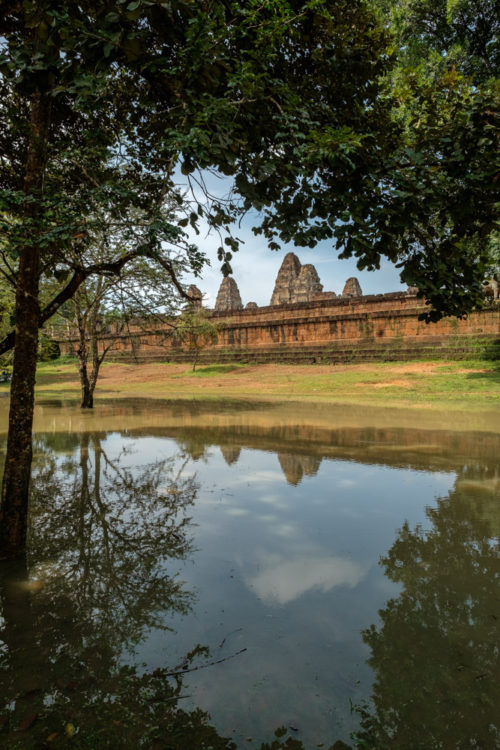
You need to use quite a bit of imagination when visiting the East Mebon temple. It’s not that the temple is badly ruined. The imagination is needed to think of the temple as it originally existed, as an island in the middle of a large artificial lake, the Eastern Baray.
Ta Som
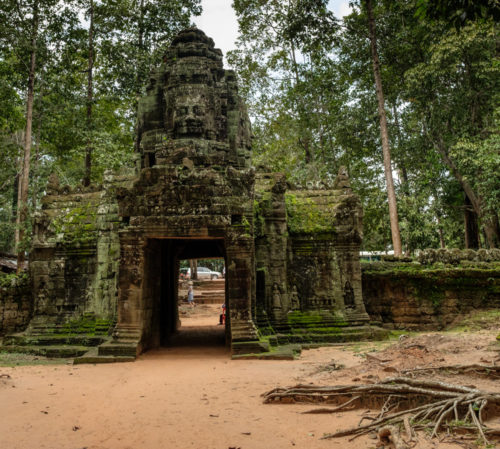
The Ta Som is a small temple at the Eastern edge of the Jayatataka baray. The Bayon style monument was built by King Jayavarman VII in the late 12th century. The King dedicated Ta Som to his father Dharanindravarman II who was King of the Khmer Empire from 1150 to 1160.
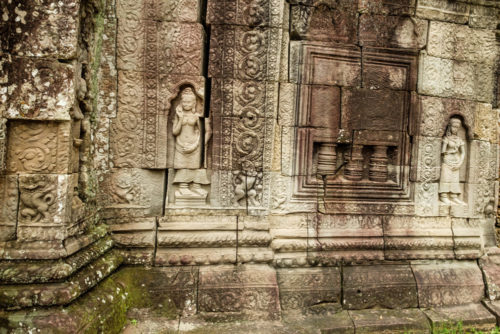
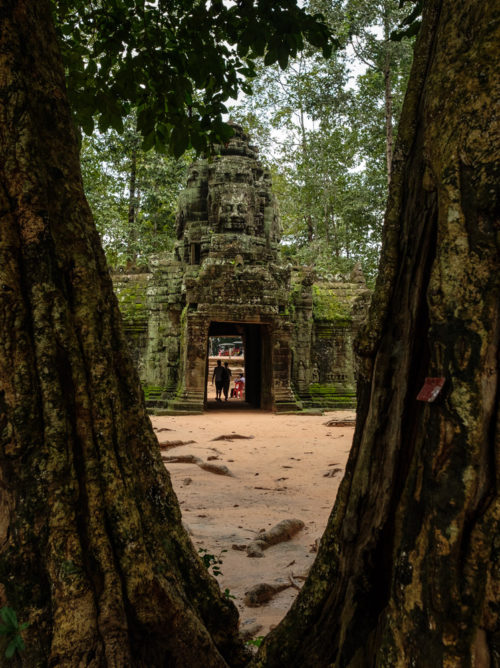
The Bayon style is evident in the East and West gopura entrance building of the outer enclosure, which are topped with large faces of Lokeshvara, the Bodhisattva of compassion, facing all four directions.
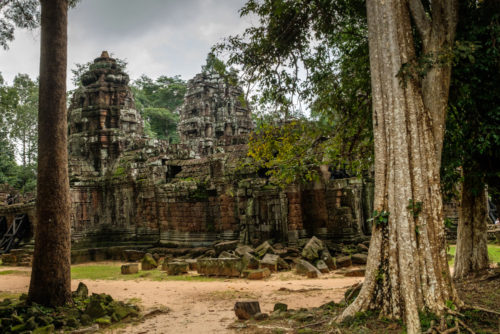
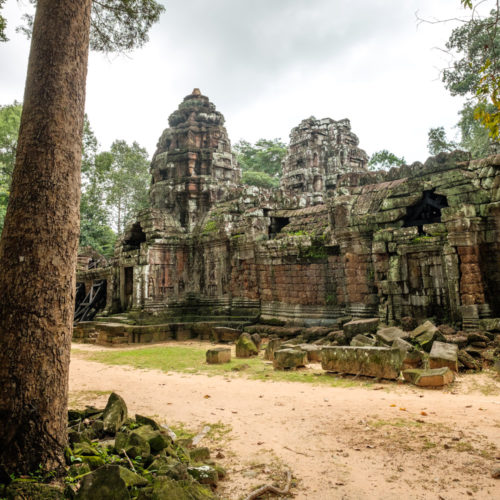
The temple is oriented towards the East. Three enclosures and a moat surround a single sanctuary tower in the center of the temple. Dedicated to the Buddha, the lintels and pediments of the Ta Som also contain sculptings of Hindu depictions.

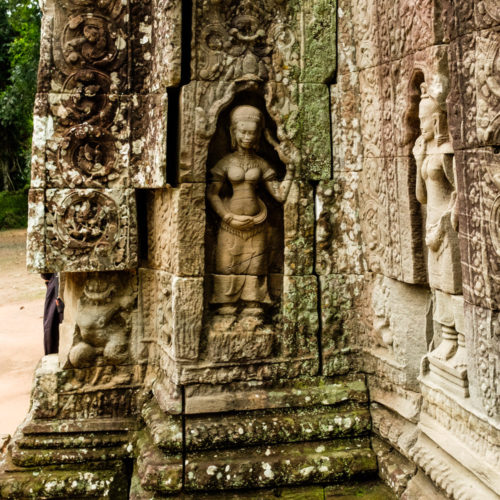
The outer enclosure measures 200 meters long by 250 meters wide. The laterite wall is intersected by a gopura entrance building on the East and West side. Both gopuras are topped with large faces of Lokeshvara facing each of the cardinal directions, in a similar style as those of the Bayon, a temple built by the same King.
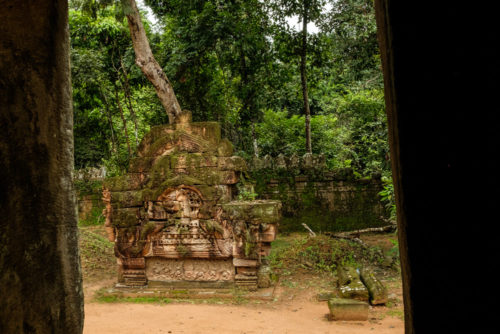
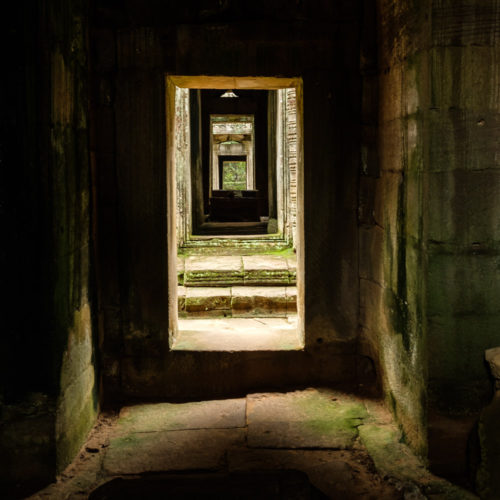
At the center of the cruciform gopuras is the entrance gate topped with a tower with diminishing tiers. Flanking it are two small rooms with windows. The walls are adorned with sculpted devatas, while the lintels contain a carving of a standing Lokeshvara, the arms stretched out, flanked by sculptings of a number of devotees. The East gopura building, the main entrance of the Ta Som, is overgrown a sacred fig (Ficus religiosa) which has grown down through the blocks that make up the gopura and into the ground.
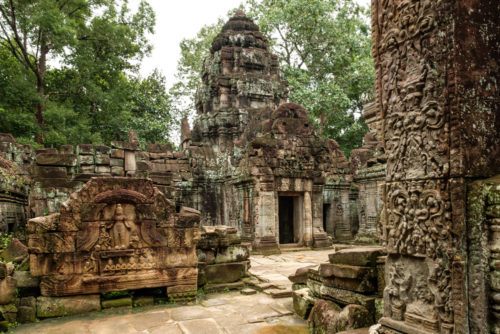
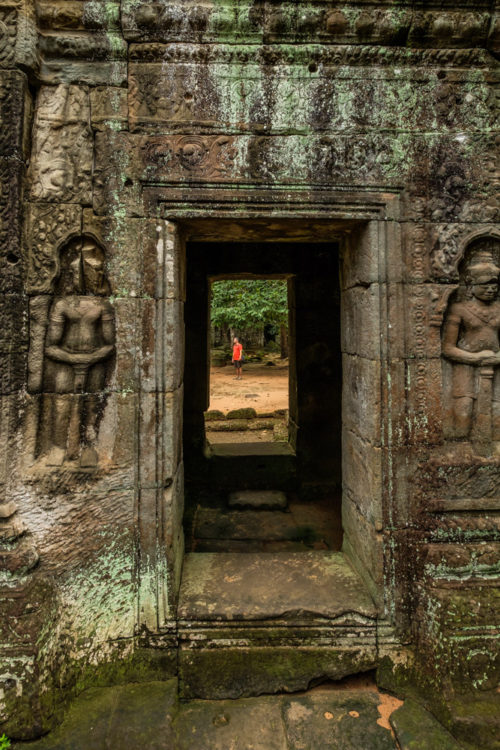
A walkway from the gopura of the third enclosure leads towards the moat. Approaching from the East, the walkway is flanked by two small structures. A cruciform terrace crosses the moat to the second enclosure. The laterite wall of the second enclosure is intersected by gopura entrance buildings with porticoes.
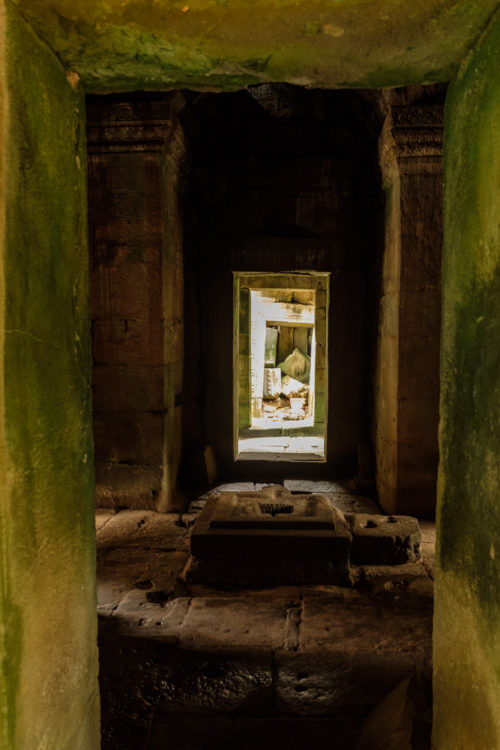
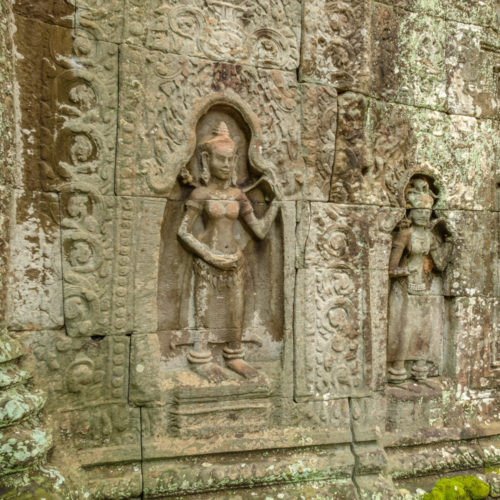
The first enclosure measuring 30 meters long by 20 meters wide is enclosed by galleries. At each of the four corners of the galleries are corner pavilions, while at the center of each side is a gopura entrance building topped with a tower with two tiers of diminishing size. Sculptings of armed dvarapalas on the walls guard the inner sanctuary. On the inner courtyard near the South East and North East corner pavilions are two library buildings, of which the South one is best preserved.
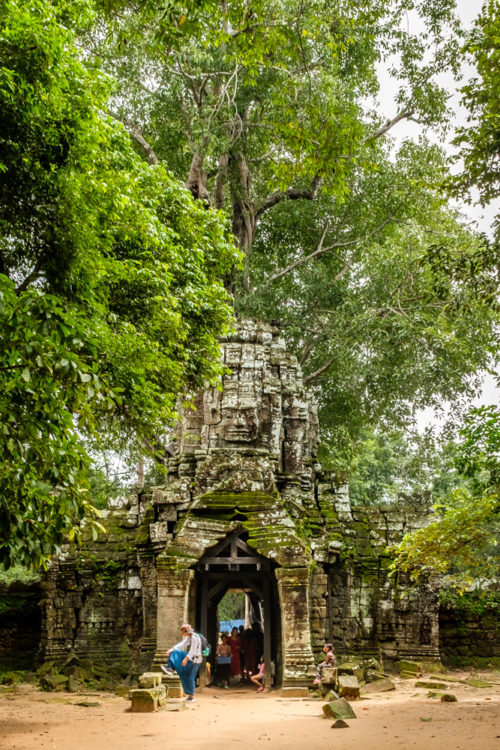
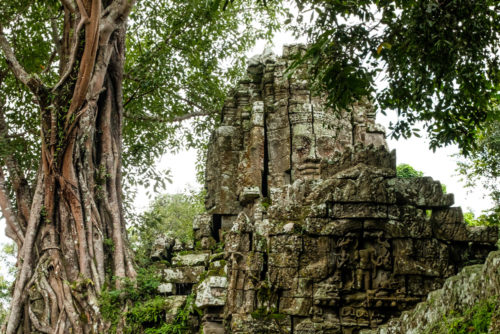
In the center stands a single cruciform sanctuary, with an entrance preceded by a vestibule on each of its four sides. The pediments and lintels contain both Hindu and Buddhist depictions. Several depiction of the Buddha have been defaced in the 13th century, when the official Angkor religion was changed back to Hindu. Two small libraries sit on either side of the eastern entrance path. Ta Som is the most distinct temple on the Grand Circuit.
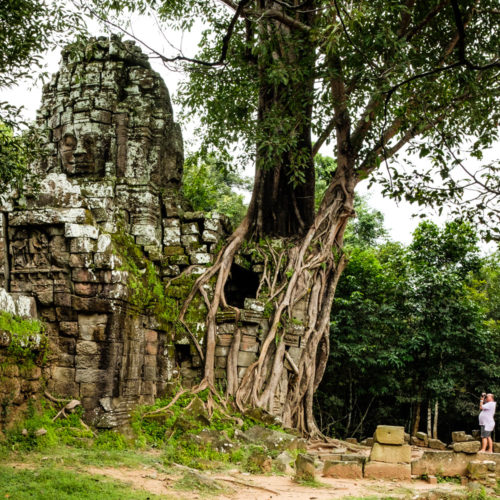
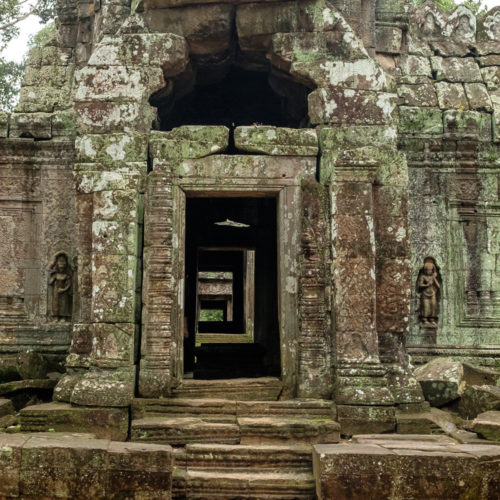
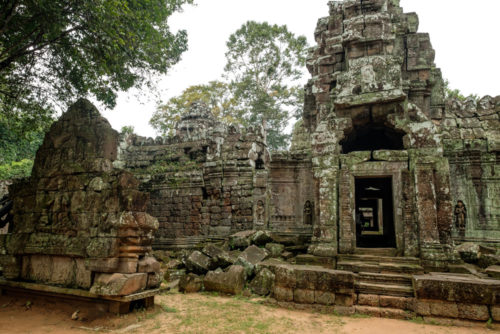
Neak Pean

Cambodia is one of the worst affected by the landmine planted during the war between Khmer rouge and Vietnam. You will be able to see several victim of the devastation and they will be singing using traditional music and collect funds for rehabilitation. Almost every temple you go to will have numerous hawkers or sales people asking you to buy there items. Many they are young children that do half day selling items and half day at school. Smile, but don’t stop and say No Thank you firmly (I find English or Khmer “ot’aye akun” works, so long as you’re firm but friendly). If you want to take it a step further try “ot drow-gaar” which literally means “I don’t need it” and is a little less abrupt than ‘no’ or ‘I don’t want it’.
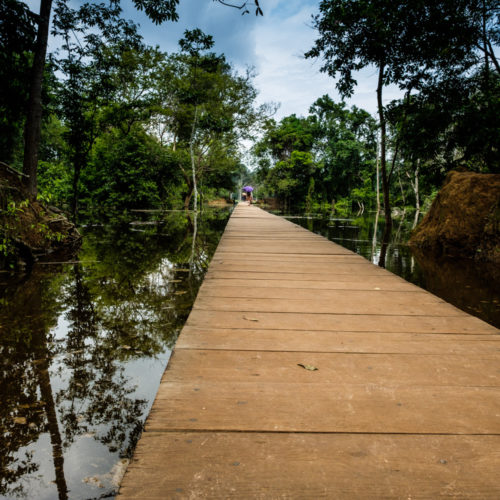
Neak Pean, “the entwined snakes” is a small temple located on an island in the center of the Jayatataka baray, a water reservoir 3,500 meter long and 900 meter wide. Initially dedicated to the Buddha, the temple was rededicated to Lokeshvara, the Bodhisattva of compassion.
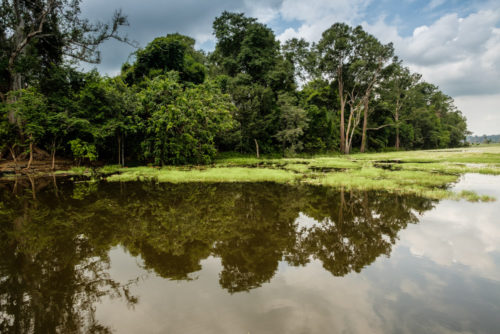
Much of the temple area is flooded during the rainy season. So whatever I am explaining below was all under water when we visited. I am explaining for those who plan to visit during slightly drier season to this wonderful place. A wooden walkway over the waters leads to the central sanctuary, which is fenced off to protect it from further decay.
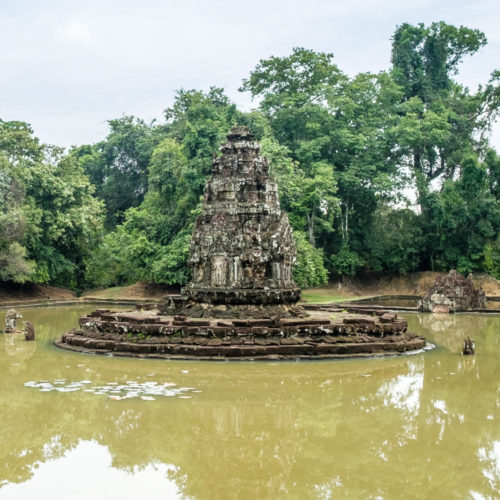
The temple area on the island in the center of the Jayatataka baray is enclosed by a square laterite wall measuring 350 meters wide, in which were contained a number of ponds. While the outer ponds have gone, the central pond and four surrounding ponds remain.
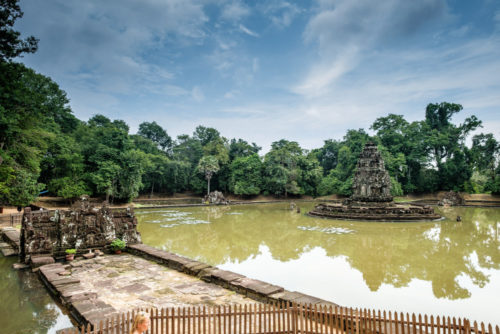
The central pond of Neak Pean symbolizes lake Anavatapta, a lake located in the center of the world in Buddhist cosmology. At each of its four sides is a smaller pond (srah) and a chapel connecting the large central pond with the surrounding ones. The four chapels were used by pilgrims who would wash away their sins in the cleansing waters of the central pond. In each chapel there is a stone gargoyle in a different shape, namely a head of a King, an elephant, a lion and a horse. Through their open mouths flowed water that filled that chapel’s small basins with the healing waters from the central pool. Each of the chapels contains a base, on which the main idol stood. Several depictions of Lokeshvara can be found inside the chapels.
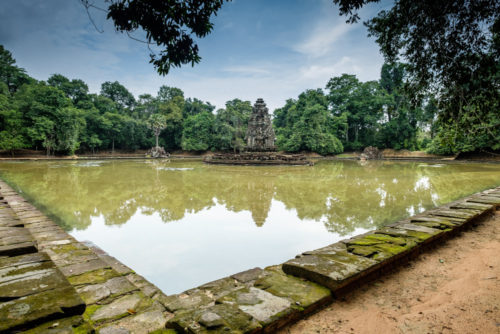
In the center of the central pond is a circular island with a diameter of 14 meters, on which stands the sanctuary. The sandstone sanctuary is set on a circular stone base, encircled by two Naga snakes, guarding the East entrance of the temple. At the other end (West) their tales intertwine, from which the temple derives its name; Neak Pean translates to “the entwined snakes”.
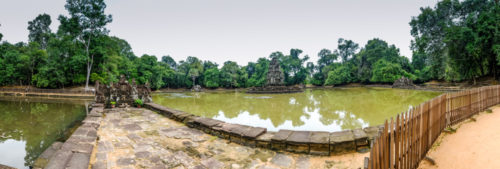
Originally the sanctuary had doors on each of the four cardinal directions. At one point three of them were closed, leaving just the East entrance. The false doors were adorned with large carved depictions of Lokeshvara, believed to possess the powers of healing. On the pediment over the East entrance is a depiction of the Buddha. The image of the Buddha that was enshrined inside the sanctuary is no longer there.
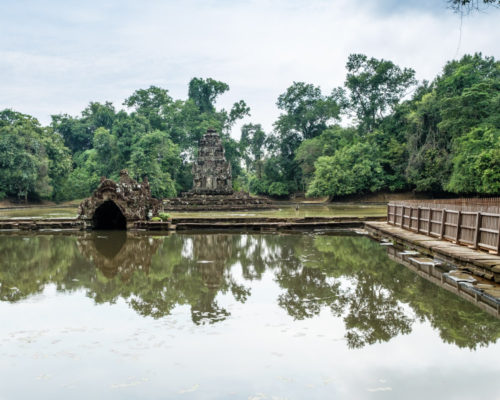
Scattered around the central sanctuary are several lingas (the representation of Shiva), and Yonis (the female counterpart of the linga). In front of the East entrance stands a statue of the flying horse Balaha, often partly submerged in the rainy season.
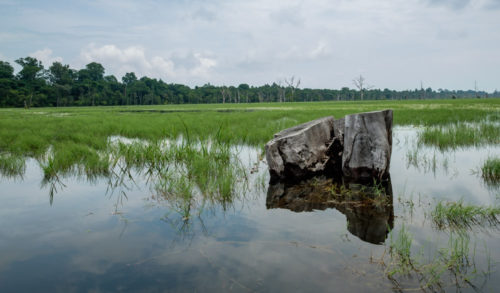
The flying horse Balaha depicts a story from one of the Jataka tales, the stories that tell about the previous lives of the Buddha. A group of merchants were sailing the ocean, when a violent storm broke out that wrecked their ship. Clinging on to pieces of wood from the broken ship the merchants ended up on a beach of an island named Singhala. The island was inhabited by demons, that took the shape of attractive young women. The sailors were warmly welcomed by the women, who took them to their homes where they had children and lived as a family.
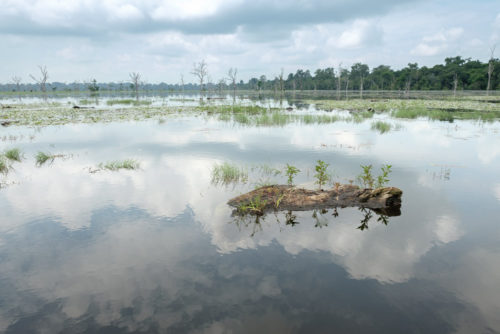
One night the captain of the ship discovered a house with no doors and no windows from where loud cries of misery and weeping emerged. Locked inside the house were merchants previously stranded on the island, who told the captain that the women were in fact demons and that they had to escape the island while they still had the chance. Once a month the flying horse Balaha would appear on the island to rescue stranded sailors. The merchants are seen clinging to the horse’s manes and tail, escaping danger.
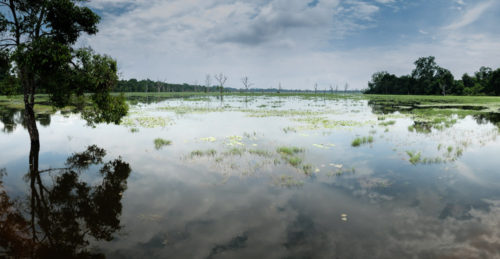
The story serves as a reminder not to focus on worldly matters and temptations and instead reach for lasting happiness by following the teachings of the Buddha. Replica of the same flying horse Balaha, can be seen in front of Siem Reap International Airport (check the first part of this blog).
By the time we finished seeing Neak Pean we were hungry. Our Tuk Tuk driver guided us to the food court next to the Neak Pean which had very sumptuous and tasty khmer lunch. Khmer cuisine consists of more than one dish and ideally contrasts flavours, textures and temperatures within the meal using plenty of herbs, leaves, pickled vegetables, dipping sauces, edible flowers and other garnishes and condiments. The staple food for Cambodians is rice. Plain white rice is served with nearly every dish you order, typically served with grilled freshwater fish, a samlor or soup, and an assortment of seasonal herbs, salad leaves and vegetables. Amok is thick soup cooked with fish, meat, vegetables,eggs and coconut milk, is a sort of national dish of Cambodia.
As the blog is getting too lengthy, I will break this here. In the next part of the blog I will cover post lunch exploration of Preah Khan, which is a huge monastic complex. Later that evening we went to watch the Phare, The Cambodian Circus. We ended the day at Bugs Café exploring Insect Tapas food in Cambodia. For all that exciting details, you need to wait for part 3 of this journey.
Thanks to all of you for being part of this journey and encouraging me to write this travelogue. If you have missed earlier, check all the 8 parts with links below.

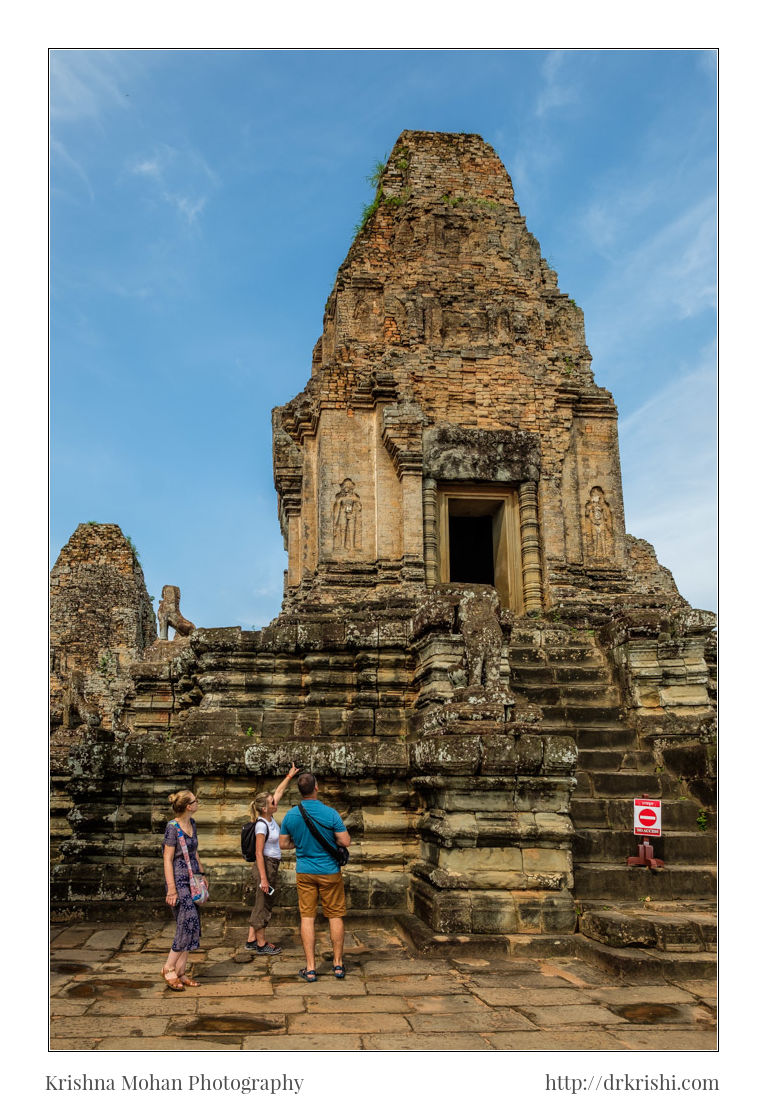
Wao… Sir.. too good. Eagerly awaiting part 3. It was my dream destination. I feel I am around it now..Thanks..
Coincidentally my nephew and his wife just returned from here after their honey moon. Lovely place. They’d visited Vietnam and Cambodia.
ಆಹಾ, ಕಾಂಬೋಡಿಯದಲ್ಲೂ ಒಬ್ಬ ತುಗ್ಲಕ್!
ಸಪುರ ಕುತ್ತ ಮೆಟ್ಟಿಲು ಹತ್ತಲು ಬಚ್ಚುವವರೆಲ್ಲ ಮೊದಲೇ ಸೈಕಲ್ ಮೆಟ್ಟಿ ಗಟ್ಟಿಯಾಗಿ ಹೋಗಬೇಕಿತ್ತು 🙂
ಮೂಡಬಿದ್ರೆ, ಕಾರ್ಕಳಗಳ ಕೆರೆ ದೇವಳಗಳ ನೆನಪು ಹುಟ್ಟಿಸುತ್ತದೆ. ನೀರು ಕೊಳಚೆಯಾಗಿಲ್ಲಾಂತ ಕಾಣುತ್ತದೆ, ಸದ್ಯ!
ಉದ್ದದ ಮರದ ಸೇತುವೆ ಮಾಡಿದವರಿಗೆ ನಮ್ಮ ಬೆಂಗಳೂರಿನ ಉಕ್ಕಿನ ಸೇತುವೆ ಕಳಿಸಿಕೊಡೋಣ. (ಇನ್ನೂ ಹೆಚ್ಚಿನದು ಮೂರನೇದು ಓದಿದ ಮೇಲೆ…..)
Nicely presented… thanks for sharing every detail, very informative & helpful